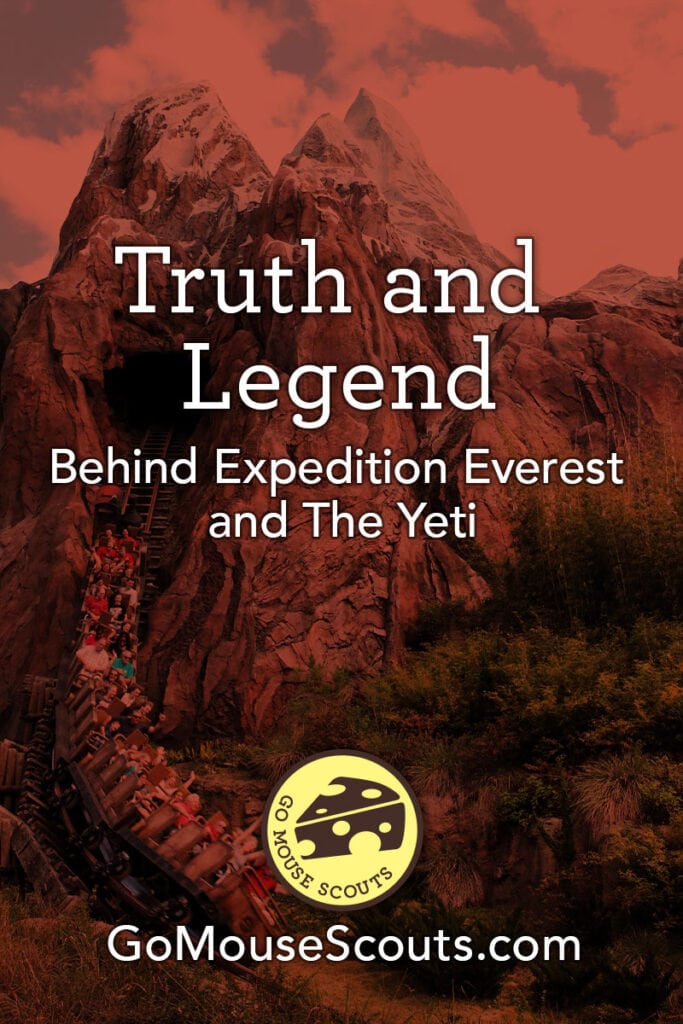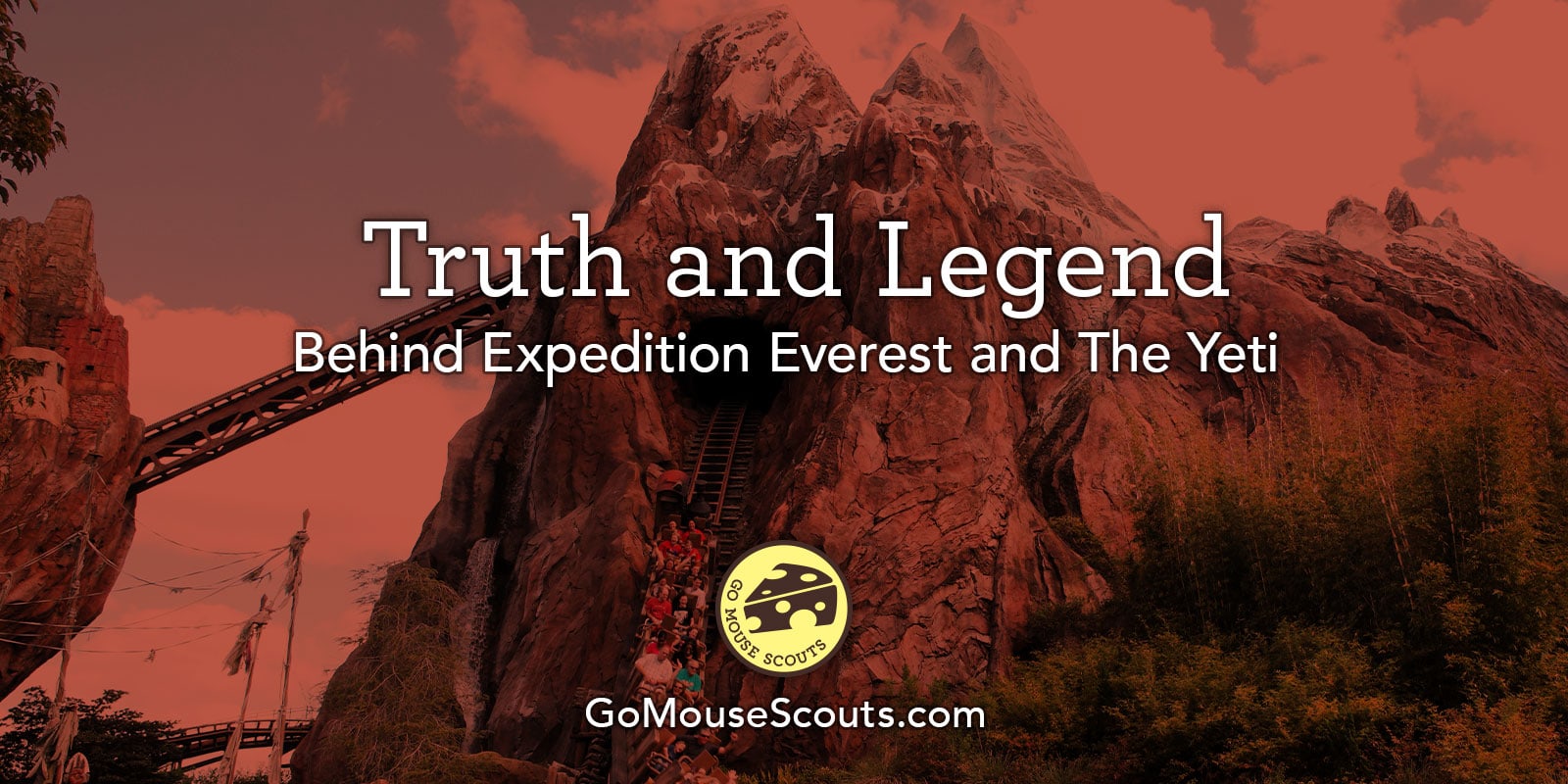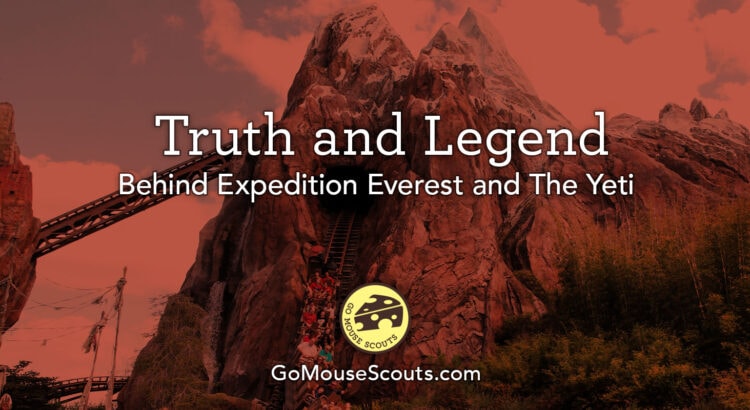
Expedition Everest at Disney’s Animal Kingdom in Walt Disney World is inspired by Mount Everest and the legend of the Yeti. As you travel through the queue, you’ll walk by shrines dedicated to the Yeti, photos, artifacts, and various pieces of evidence pointing to their existence.
Disney’s story for Expedition Everest goes something like this: The region had once been a booming tea plantation, using trains to deliver the tea to Anandapur. Mysteriously, the plantation suddenly shut down and the trains stopped running. Now new businesses like The Himalayan Escapes Tour & Expeditions Company have cropped up that arrange expeditions into the “forbidden mountains” using the old Royal Anandapur Tea Company trains and tracks. The only problem is the legend of the Yeti. As you travel through the mountain it becomes clear that the legend is true and you’re being chased by the infamous creature!
Who is the Yeti? Where does the legend come from? And who are the people who believe in the Yeti?
Tucker, Corey. “What's the Real Story: Expedition Everest.” The Main Street Mouse, 16 Apr. 2020, www.themainstreetmouse.com/2014/07/01/whats-the-real-story-expedition-everest/. Accessed 4 Aug. 2021.
Tell Me About Mount Everest
Part of the Himalayan Mountain Range, Mount Everest is the tallest mountain in the world, standing at an elevation of 29,032 feet (8,849 meters). The Himalayan Mountain Range can be found on the continent of Asia and separates the Plateau of Tibet to the North from the Indian subcontinent to the south. Everest sits at the border of Tibet and Nepal at the Eastern end of Nepal. (See map below.)
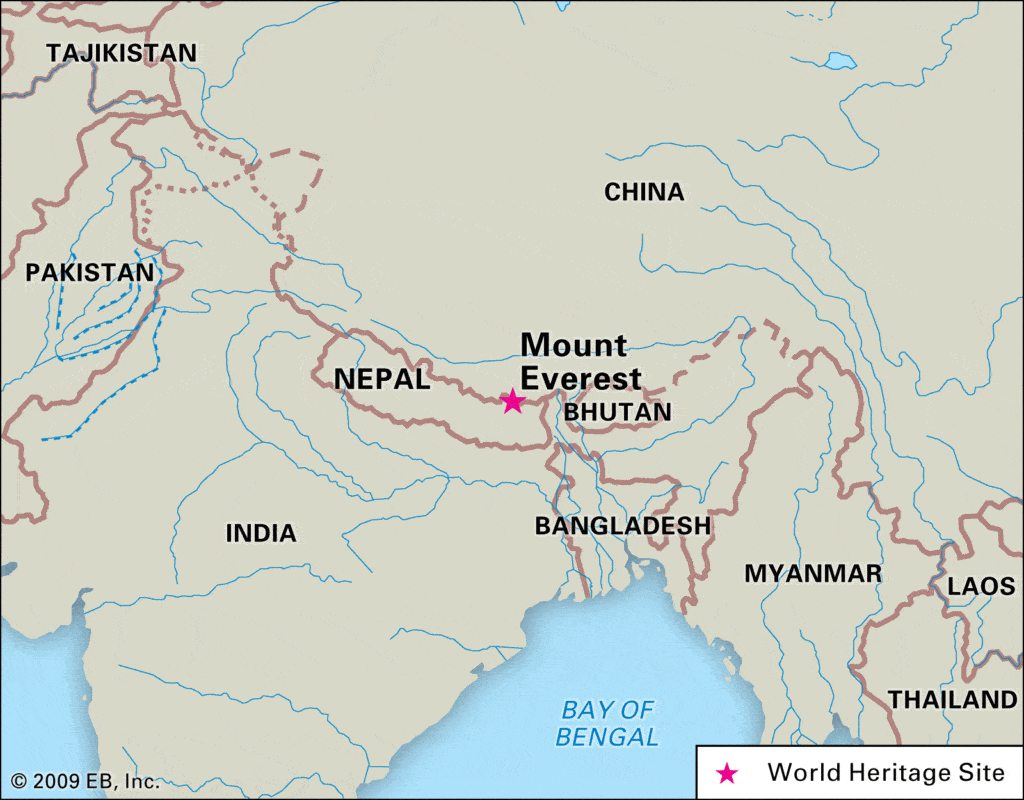

by Near Human Intelligence at TeePublic!
Mount Everest has many names from the many cultures that surround it. In Tibet, it is named Chomolungma, which means “Mother Goddess of the World.” In Nepal, it’s called Sagarmatha, which translates to “Peak of Heaven.”
In 1865, the mountain was named Everest after Sir George Everest, a British geodesist who introduced cutting edge surveying instruments which brought greater accuracy to the science. He also played a large role in surveying India from the Himalayas to Cape Comorin.
The climate of Mount Everest is very hostile to the living. During the summer months, the warmest it ever gets is about −2 °F (−19 °C) at the summit. In the winter months, you’ll see an average temperature of −33 °F (−36 °C) with numbers dipping as low as −76 °F (−60 °C).
The extreme weather is also affected by the fact that storms can appear suddenly, bringing winds with sustained speeds of more than 100mph and snow during the summer wet season. Temperatures can drop very quickly and unexpectedly. Because of this, it is very dangerous for climbers and Everest has claimed its share of victims.
"Mount Everest." Britannica School, Encyclopædia Britannica, 13 May. 2021. school.eb.com/levels/high/article/Mount-Everest/33358. Accessed 24 Jul. 2021.
"Himalayas." Britannica School, Encyclopædia Britannica, 19 Mar. 2021. school.eb.com/levels/high/article/Himalayas/110521. Accessed 24 Jul. 2021.
"Sir George Everest." Britannica School, Encyclopædia Britannica, 20 Jul. 1998. school.eb.com/levels/high/article/Sir-George-Everest/33357. Accessed 24 Jul. 2021.
Who are the People Around Mount Everest?
While the mountain itself is unable to sustain human life, the people that surround Everest in the valleys are mainly Tibetan-speaking folks. Most notable among these people are the Sherpas who guide people wanting to climb the mountain.
The Sherpas live year around at high altitudes and are accustomed to the weather and climate conditions. This adaptation allows them to guide the mountain climbers who travel from all over the world for their chance to conquer the mountain and make it to the top. Sherpas are hired to assist climbers in many ways, including setting up camp, managing the porters who carry all the luggage and supplies, ensuring all the loads are evenly distributed, and ultimately being responsible for the safety of the climbing party.
Mountain climbers and trekkers are another very important group of people on the mountain, as their increased numbers over the years have changed the livelihoods of the Sherpas; they’ve come to depend more on climbing expeditions for income to support their families. An interesting note is that the mountain is sacred to the Sherpa people, and many of the people have been unwilling to climb Mount Everest over the years.
"Sherpa." Britannica School, Encyclopædia Britannica, 28 Jun. 2017. school.eb.com/levels/high/article/Sherpa/67323. Accessed 24 Jul. 2021.
Foreman, Bruce. “The Sherpa Cheat Sheet: 9 Things You Were Embarrassed to Ask.” CNN, Cable News Network, 12 July 2017, www.cnn.com/travel/article/sherpa-facts/index.html. Accessed 24 Jul. 2021.
What is the Legend of the Yeti
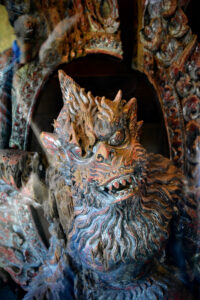
The Tibetan Yeti, or Abominable Snowman, is a cryptid, a legendary animal whose existence has been suggested but is not recognized by science. The Yeti is most commonly described as being ape-like in appearance, with dark gray or reddish brown hair, standing roughly six feet tall. Sightings of it have been reported along the snow line of the Himalayas, but many believe it may in fact live among the Himalayan forests which could be better able to support such a being.
There have been many expeditions over the years which have set out to prove the existence of the Yeti. Such apparent evidence as footprints, bones, and hair have been attributed to the creature, yet there is no scientifically backed evidence. People have claimed sightings for over 2,000 years; in fact Alexander the Great himself demanded to see one when he conquered the local people! (They told him the Yeti could not survive being brought out of the mountains.)
Other similar creatures have been seen around the world as well, like Sasquatch in America, Yowie in Australia, Mapinguari in South America, and Orang Minyak in Malaysia.
Here in Florida, we have our very own Bigfoot-like cryptid called The Skunk Ape! He’s been spotted mostly in the Everglades and is aptly named for the pungent odor people experience when they sight him.
"Abominable Snowman." Britannica School, Encyclopædia Britannica, 4 Jun. 2018. school.eb.com/levels/high/article/Abominable-Snowman/3375. Accessed 4 Aug. 2021.
McNeely, J. A., et al. “The Yeti — Not a Snowman.” Oryx, vol. 12, no. 1, 1973, pp. 65–73., doi:10.1017/S0030605300011108.
Radford, Benjamin. “The Yeti: Asia's Abominable Snowman.” LiveScience, Purch, 28 Nov. 2017, www.livescience.com/25072-yeti-abominable-snowman.html. Accessed 4 Aug. 2021.
Wolchover, Natalie. “Why Do so Many Cultures Have a Version of Bigfoot?” LiveScience, Purch, 21 June 2012, www.livescience.com/34021-bigfoot-yeti-myth.html. Accessed 4 Aug. 2021.
Stromberg, Joseph. “On the Trail of Florida's Bigfoot-the Skunk Ape.” Smithsonian.com, Smithsonian Institution, 6 Mar. 2014, www.smithsonianmag.com/science-nature/trail-floridas-bigfoot-skunk-ape-180949981/. Accessed 4 Aug. 2021.
Featured image: Expedition Everest by Steven Miller
